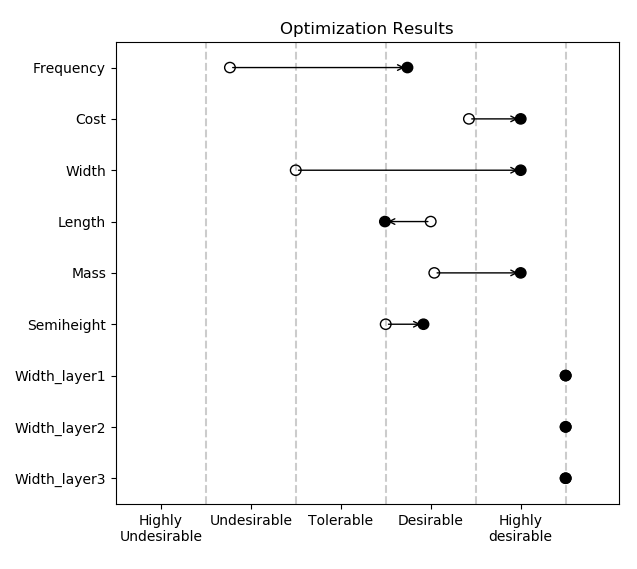physprog ("Physical Programming") is a tool for people who have something with multiple metrics they want to optimize simultaneously. You may be an engineer wanting to minimize the cost, minimize the weight, and maximize the width of a widget. Or you may be a fund manager trying to maximize your up-market capture ratio while minimizing your down-market capture ratio.
Regardless of what you want to optimize, it's often a dark art to weight multiple performance metrics into one aggregate objective function to be passed off to a general purpose function minimizer.
physprog eliminates the guess-work by taking meaningful preferences for each performance metric and building the aggregate objective function for you. With this, you can focus your time on adjusting the design of your product and less time (no time, really) adjusting the weights so that they accurately reflect your preferences.
physprog is an implementation of the Messac's Physical Programming algorithm [1]. For each performance metric, you express your preferences by defining the boundaries between 6 preference regions:
- Highly Desirable
- Desirable
- Tolerable
- Undesirable
- Highly Undesirable
- Unacceptable
You can choose between several class functions to reflect these preferences, such as:
- Smaller is better
- Larger is better
- Value is better
- Range is better
Of course, you can also define hard constraints for performance metrics, as in: "thickness has to be at least 1mm."
physprog can just hand you the objective function for you to pass on to whatever optimization routine you prefer, or it has some basic code to pass it through scipy.optimize.minimize and do the full optimization for you.
The code for this project, as well as the issue tracker, etc. is hosted on GitHub
Directly from source:
git clone git@github.com:partofthething/physprog.git
cd physprog
python setup.py install
To use physprog you need two things: your preferences and a model.
You specify your preferences in a YAML input file. The bounds input should go from most desirable to least desirable, where anything beyond the last bound is unacceptable. Here's an example:
dependents:
- name: frequency
class: LargerBetter
units: Hz
bounds:
- 200.0
- 150.0
- 120.0
- 110.0
- 100.0
- name: cost
class: SmallerBetter
units: kg
bounds:
- 1000.0
- 1800.0
- 1900.0
- 1950.0
- 2000.0
- name: width
class: MustBeAbove
units: m
bound: 0.01NOTE: You can also specify preferences in a dictionary and bypass the input file.
Your model must take inputs and produce outputs. Inputs should be
defined in a tuple or list in the same order that your preferences were
specified in. Outputs corresponding to inputs should be computed
by an evaluate method. There should be a method named after each of
your dependent variables. With the example preferences above, your model
may look like:
SampleDesign = namedtuple('SampleDesign', ['d1', 'd2', 'd3', 'b', 'L'])
class SampleProblemBeam(object):
"""Dummy sample problem."""
def __init__(self):
self._design = SampleDesign(0.3, 0.35, 0.40, 0.40, 5.0) # initial
def evaluate(self, x=None):
"""Convert input design into output design parameters."""
if x is not None:
self.design = x
return [self.frequency(), self.cost(), self.width()]
def frequency(self):
return math.pi / (2 * self.design.L ** 2) * self.design.d2
def cost(self):
ds = self.design
return 2 * ds.b * ds.L
def width(self):
return self.design.bA complete sample problem involving the design of a beam is included in the tests.
To compute the optimal design of your thing, do something like this:
from physprog import classfunctions, optimize
preferences = classfunctions.from_input('input.yaml')
model = SampleProblemBeam()
optimize.optimize(model, preferences, plot=True)The results of the full sample problem are shown below:
If you just want an aggregate objective function without optimizing, you can do this:
from physprog import classfunctions, objective
preferences = classfunctions.from_input('input.yaml')
model = SampleProblemBeam()
aggregate = objective.build_objective(model, preferences)Then you can pass the aggregate to any other optimization engine.
You are encouraged to make contributions to make this system more
useful to everyone. There are automated tests that run with the
tox command so make sure those all pass (including style checks)
before submitting a PR. If you have a big change in mind you
may want to contact the author
This package is released under the Apache-2.0 license reproduced here.
